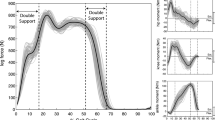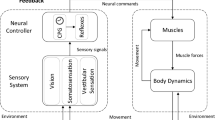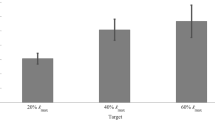Abstract
Human walking is a complex task, and we lack a complete understanding of how the neuromuscular system organizes its numerous muscles and joints to achieve consistent and efficient walking mechanics. Focused control of select influential task-level variables may simplify the higher-level control of steady-state walking and reduce demand on the neuromuscular system. As trailing leg power generation and force application can affect the mechanical efficiency of step-to-step transitions, we investigated how joint torques are organized to control leg force and leg power during human walking. We tested whether timing of trailing leg force control corresponded with timing of peak leg power generation. We also applied a modified uncontrolled manifold analysis to test whether individual or coordinated joint torque strategies most contributed to leg force control. We found that leg force magnitude was adjusted from step to step to maintain consistent leg power generation. Leg force modulation was primarily determined by adjustments in the timing of peak ankle plantar-flexion torque, while knee torque was simultaneously covaried to dampen the effect of ankle torque on leg force. We propose a coordinated joint torque control strategy in which the trailing leg ankle acts as a motor to drive leg power production while trailing leg knee torque acts as a brake to refine leg power production.








Similar content being viewed by others
References
Af Klint R, Mazzaro N et al (2010) Load rather than length sensitive feedback contributes to soleus muscle activity during human treadmill walking. J Neurophysiol 103(5):2747–2756
Auyang AG, Yen JT et al (2009) Neuromechanical stabilization of leg length and orientation through interjoint compensation during human hopping. Exp Brain Res 192(2):253–264
Bauman JM, Chang YH (2013) Rules to limp by: joint compensation conserves limb function after peripheral nerve injury. Biol Lett 9(5):20130484
Bosco G, Poppele RE (2000) Reference frames for spinal proprioception: kinematics based or kinetics based? J Neurophysiol 83:2946–2955
Bosco G, Poppele RE et al (2000) Reference frames for spinal proprioception: limb endpoint based or joint-level based? J Neurophysiol 83:2931–2945
Capaday C (2002) The special nature of human walking and its neural control. Trends Neurosci 25(7):370–376
Collins S, Ruina A et al (2005) Efficient bipedal robots based on passive-dynamic walkers. Science 307:1082–1085
Cronin NJ, Avela J et al (2013) Differences in contractile behaviour between the soleus and medial gastrocnemius muscles during human walking. J Exp Biol 216(5):909–914
Daley MA, Biewener AA (2006) Running over rough terrain reveals limb control for intrinsic stability. Proc Natl Acad Sci USA 103(42):15681–15686
Daley MA, Felix G et al (2007) Running stability is enhanced by a proximo-distal gradient in joint neuromechanical control. J Exp Biol 210(3):383–394
Donelan JM, Kram R et al (2002a) Mechanical work for step-to-step transitions is a major determinant of the metabolic cost of human walking. J Exp Biol 205(23):3717–3727
Donelan JM, Kram R et al (2002b) Simultaneous positive and negative external mechanical work in human walking. J Biomech 35(1):117–124
Faist M, Hoefer C et al (2006) In humans Ib facilitation depends on locomotion while suppression of Ib inhibition requires loading. Brain Res 1076:87–92
Farris DJ, Sawicki GS (2012) Human medial gastrocnemius force-velocity behavior shifts with locomotion speed and gait. Proc Natl Acad Sci USA 109(3):977–982
Garcia M, Chatterjee A et al (2000) Efficiency, speed, and scaling of two-dimensional passive-dynamic walking. Dyn Stab Syst 15(2):75–99
Gorniak SL, Zatsiorsky VM et al (2007) Emerging and disappearing synergies in a hierarchically controlled system. Exp Brain Res 183(2):259–270
Gorniak S, Zatsiorsky V et al (2009) Hierarchical control of static prehension: II. Multi-digit synergies. Exp Brain Res 194(1):1–15
Granata P, Marras WS (2000) Cost–benefit of muscle cocontraction in protecting against spinal instability. Spine 25(11):1398–1404
Ishikawa M, Komi PV et al (2005) Muscle-tendon interaction and elastic energy usage in human walking. J Appl Physiol 99(2):603–608
Kepple TM, Siegel KL et al (1997) Relative contributions of the lower extremity joint moments to forward progression and support during gait. Gait Posture 6(1):1–8
Khatib O (1987) A unified approach for motion and force control of robot manipulators—the operational space formulation. IEEE J Robot Autom 3(1):43–53
Kim M, Collins SH (2015) Once-per-step control of ankle-foot prosthesis push-off work reduces effort associated with balance during walking. J Neuroeng Rehabil 12:43
Kram R, Griffin TM, Donelan JM, Chang YH (1998) Force treadmill for measuring vertical and horizontal ground reaction forces. J Appl Physiol 85:764–769
Kuo AD (2002) Energetics of actively powered locomotion using the simplest walking model. J Biomech Eng Trans ASME 124(1):113–120
Kurz MJ, Judkins TN et al (2008) A passive dynamic walking robot that has a deterministic nonlinear gait. J Biomech 41:1310–1316
Latash ML, Scholz JP et al (2002) Motor control strategies revealed in the structure of motor variability. Exerc Sport Sci Rev 30(1):26-31
McGeer T (1990) Passive dynamic walking. Int J Robot Res 9(2):62–82
Neptune RR, Kautz SA et al (2001) Contributions of the individual ankle plantar flexors to support, forward progression and swing initiation during walking. J Biomech 34(11):1387–1398
Neptune RR, Zajac FE, Kautz SA (2004) Muscle mechanical work requirements during normal walking: the energetic cost of raising the body’s center-of-mass is significant. J Biomech 37:817–825
Nichols TR (1999) Receptor mechanisms underlying heterogenic reflexes among the triceps surae muscles of the cat. J Neurophysiol 81(2):467–478
Nielsen JB, Sinkjaer T (2002) Afferent feedback in the control of human gait. J Electromyogr Kinesiol 12:213–217
Nilsson J, Thorstensson A (1989) Ground reaction forces at different speeds of human walking and running. Acta Physiol Scand 136(2):217–227
Roberts TJ (2002) The integrated function of muscles and tendons during locomotion. Comp Biochem Physiol Mol Integr Physiol 133(4):1087–1099
Roberts TJ, Azizi E (2011) Flexible mechanisms: the diverse roles of biological springs in vertebrate movement. J Exp Biol 214(3):353–361
Roberts TJ, Marsh RL (2003) Probing the limits to muscle-powered accelerations: lessons from jumping bullfrogs. J Exp Biol 206(15):2567–2580
Ruina A, Bertram JEA et al (2005) A collisional model of the energetic cost of support work qualitatively explains leg sequencing in walking and galloping, pseudo-elastic leg behavior in running and the walk-to-run transition. J Theor Biol 237:170–192
Sawicki GS, Robertson BD, Azizi E, Roberts TJ (2015) Timing matters: tuning the mechanics of a muscle-tendon unit by adjusting stimulation phase during cyclic contractions. J Exp Biol 218(19):3150–3159
Sefati S, Neveln ID, Roth E, Mitchell TRT, Snyder JB, MacIver MA, Fortune ES, Cowan NJ (2013) Mutually opposing forces during locomotion can eliminate the tradeoff between maneuverability and stability. PNAS 110(47):18798-18803
Shim JK, Latash ML et al (2003) Prehension synergies: trial-to-trial variability and hierarchical organization of stable performance. Exp Brain Res 152(2):173–184
Stahl VA, Nichols TR (2011) Short-term effects of muscular denervation and fasciotomy on global limb variables during locomotion in the decerebrate cat. Cells Tissues Organs 193(5):325–335
Su JLS, Dingwell JB (2007) Dynamic stability of passive dynamic walking on an irregular surface. J Biomech Eng Trans ASME 129(6):802–810
Todorov E, Jordan MI (2002) Optimal feedback control as a theory of motor coordination. Nat Neurosci 5(11):1226–1235
Toney ME, Chang YH (2013) Humans robustly adhere to dynamic walking principles by harnessing motor abundance to control forces. Exp Brain Res 231(4):433–443
Verdaasdonk BW, Koopman HFJM et al (2009) Energy efficient walking with central pattern generators: from passive dynamic walking to biologically inspired control. Biol Cybern 101(1):49–61
Wilmink RJH, Nichols TR (2003) Distribution of heterogenic reflexes among the quadriceps and triceps surae muscles of the cat hind limb. J Neurophysiol 90(4):2310–2324
Winter DA (1980) Overall principle of lower-limb support during stance phase of gait. J Biomech 13(11):923–927
Yen JT, Chang Y-H (2010) Rate-dependent control strategies stabilize limb forces during human locomotion. J R Soc Interface 7(46):801–810
Yen JT, Auyang AG et al (2009) Joint-level kinetic redundancy is exploited to control limb-level forces during human hopping. Exp Brain Res 196(3):439–451
Zelik KE, Huang TWP et al (2014) The role of series ankle elasticity in bipedal walking. J Theor Biol 346:75–85
Zelik KE, Takahashi KZ, Sawicki GS (2015) Six degree-of-freedom analysis of hip, knee, ankle and foot provides updated understanding of biomechanical work during human walking. J Exp Biol 218(6):876–886
Acknowledgments
This work was supported by NINDS 5R01NS069655 and NICHD 5T32HD055180. The authors are greatly indebted to Gregory S. Sawicki and Dominic James Farris for providing the original data from their publication in PNAS 2011. The authors would like to thank Jasper Yen for his thoughtful comments and for creating much of the original MATLAB code used in this analysis. We would also like to thank members of the Comparative Neuromechanics Lab for all their helpful feedback throughout the completion of this work.
Author information
Authors and Affiliations
Corresponding author
Rights and permissions
About this article
Cite this article
Toney, M.E., Chang, YH. The motor and the brake of the trailing leg in human walking: leg force control through ankle modulation and knee covariance. Exp Brain Res 234, 3011–3023 (2016). https://doi.org/10.1007/s00221-016-4703-8
Received:
Accepted:
Published:
Issue Date:
DOI: https://doi.org/10.1007/s00221-016-4703-8




